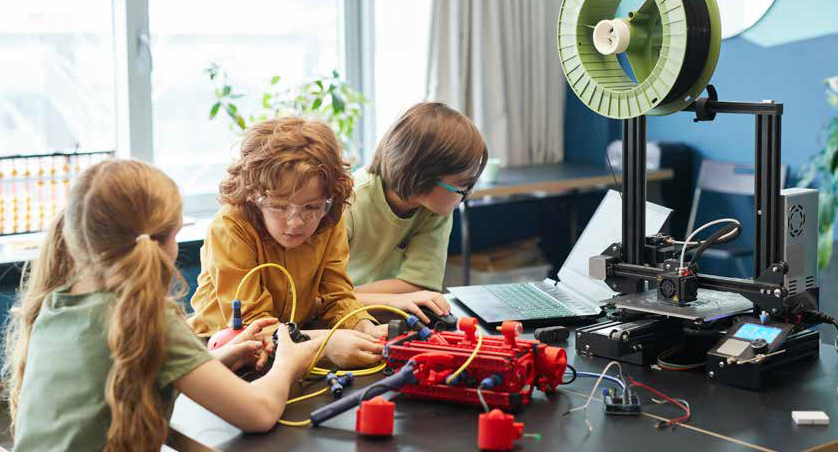Teaching and Technology
How Classrooms Are Evolving in the Digital Age

By E. Marcel Pourtout
As technology evolves, it continues to change the ways that people interact with one another— and the ways in which they exchange and absorb information. That’s particularly true in today’s classrooms, where teachers incorporate technological advances to create interactive learning environments that parents are likely to find very different from their own school experiences.The traditional classroom model is experiencing a 21st-century upgrade, with textbooks and chalkboards giving way to tablets and cutting-edge tools like 3-D printers. Technology is no longer reserved for the computer lab. Instead, students interact with technological devices on a regular basis throughout the school day.
At King’s Ridge Christian School, an independent school in Alpharetta, teachers use Activpanel interactive displays and document cameras (devices that display objects for large audiences) in every classroom. In addition, “we heavily utilize iPads,” says Director of Communications Michelle Azzi, “and our teachers also utilize platforms like Seesaw and Spelling City.”
Robots and 3-D Printers
But in today’s high-tech classroom, you’ll find much more than laptops and apps. You’re likely to see students learning about the fundamentals of robotics and creating prosthetic body parts with 3-D printers—machines that create three-dimensional objects from digital files, layer by layer.
Technology isn’t just changing the way students learn—it’s changing what they learn about, introducing them to tools and fields that once seemed like science fiction.
“Within our curriculum, students are often allowed to use technology for class projects” such as creating websites, podcasts or infographics, says Connie White, director of learning design and innovation at Woodward Academy in College Park. Students also have access to robotics, CAD (computer-aided design) and 3-D printers. They can even reserve slots in maker spaces, special areas where they engage in collaborative, hands-on projects, using contemporary technology.
“Any type of technology we have, we try to replicate it to give students a chance to use them. In our science department in particular, we have some high-level, Omni Globe (Spherical Displays) and high-powered microscopes,” White says.
The school also has several clubs geared toward technology, such as the Aviation Club, Girls Who Code and Tech Ninjas, according to its website.
At Mount Vernon School in Sandy Springs, students also can congregate in maker spaces to let their creativity run wild.
“All four maker spaces have multiple 3-D printers, and all grade levels use them for not only maker class projects but core classroom projects, as well,” says Alexandra Blumencranz, executive director for the Mount Vernon Institute for Innovation at Mount Vernon School. “The projects range from jewelry to physical representation of architecture projects to torsion-powered cars in physics.”
One early project found students working to create a prosthetic hand for teenager Alex Linkous, who was born with only part of his right hand.
“The students were led through a design thinking challenge to prototype hands that would best serve Alex and his wish to drive and hold a Coca-Cola at the same time,” Blumencranz says.
At Holy Innocents’ Episcopal School, students in grades 1 through 3 can learn the basic building blocks of 21st-century technology in an after-school Velocity Tech program, working with tools like Lego models, robot drones and 3-D pens.
A Robotics and Programming course for fourth- through sixth-graders familiarizes students with such concepts as mechanical and electrical engineering, coding and sensors as they learn to think logically and analytically. A 3-D printing class allows students in grades 4-8 to work hands-on with the equipment and even take home some of their creations. Woodward’s curriculum includes a focus on STEAM (science, technology, education, arts and math), White says.
“We have things like a coding curriculum students are involved with. Teachers use technology in lots of ways, and we’re helping them to gain or increase their skills with formative learning,” she says.
Middle-schoolers at Mount Vernon can also participate in an after-school robotics course using Lego Mindstorms, kits that combine robotics technology with Lego building blocks.
Landmark Christian School offers several specialized programs, called academies, that offer in-depth instruction in different fields of interest. “Our Aviation Academy has five flight simulators,” says Director of Marketing and Communications Paula Dobbs. The Academy of Arts and Media Production uses new iMac computers and professional-level production software to help students learn about music production and digital recording, as well as drones, HD cameras and professional-grade production software for students interested in film production.
Empowering Students
Students utilize technology outside of the classroom, from social media to streaming platforms to video games and tools that help them create music and make videos. So it only makes sense to incorporate it as a teaching aid. But educators are quick to point out that all of these devices and programs are just that—tools. The idea isn’t to make students dependent on technology—it’s Technology isn’t just changing the way students learn—it’s changing what they learn about, introducing them to tools and fields that once seemed like science fiction. 20 | Newcomer Magazine | newcomeratlanta.com for them to use it to learn and present information in new and creative ways that will keep them engaged.
“We believe in a balanced approach,” Azzi says. “The students use technology, and then we also have times where we do things by hand.”
“We give students the toolsets, skillsets and mindsets to have choice and agency in their work,” says Blumencranz. “Using their creativity and curiosity, students use these classes and materials to engage deeply in their work and make an impact in their community.”
Before and during the COVID-19 pandemic, Woodward has given all its students devices such as laptops they can take anywhere and use for homework and other projects.
“During COVID, our teachers have used our tools to scale,” White said. “We feel like it’s important that we sustain those innovations that provide all young people with the skills they need for their communities. It’s an ongoing process to use technology. That’s a shift that has occurred.”
And as technology grows more and more advanced, from robots to 3-D printers, the ways in which students use it to learn and create will continue to transform, as well.








